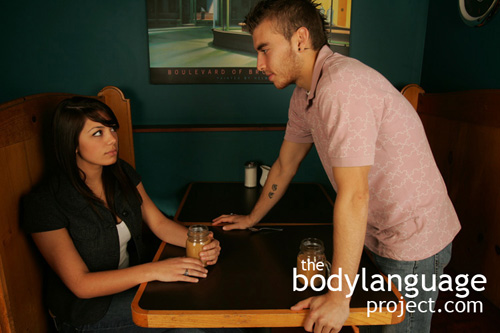
An arm cups a drink and draws in in closer while forming a shield as protection.
Blocking is a term used to describe when a person wishes to distance themselves from a distressing stimulus. Blocking is a part of the fight or flight response, and takes the form of the flight element because it creates distance between things we wish to avoid.
“Eye blocking” happens by covering the eyes either wholly or in part. When viewing disturbing images on the movie screen or even in real life, people will bring both hands up to cover their eyes or will bring them to the sides of their eyes like the blinders used on horses to keep them from being distracted. However, in this case the blinders are a nonverbal signal meant to cut something off from view instead of driving focus on them. What is being said is “Oh my dear, I can’t believe what I’m seeing.” Eye blocking is not just limited to things seen, it can be the results of hearing undesirable things as well. Blocking can be abbreviated as when one or both hands come up to rub the eyes, or seem to pinch the eyes from corner to center with just one hand. Other times, the hand comes up and covers the eyes in part, with a partly clustered set of fingers so that view isn’t entirely obstructed. This might appear as though the person is thinking, but no thought is going, just a desire to look away. Blocking can be done by briefly touching one eye with the index and middle finger in response to hearing something negative, by closing the eyelids for a longer than normal duration or more dramatically by closing them tightly in response to hearing some particularly distasteful. Blocking can also be done with books, articles of clothing or any other object.

These legs are interested – note how they are crossed toward rather than away.
Blocking can happen through the creation distance and also with arms and legs. For example, it is common for people to move away from things, and people they don’t like, and move closer to things and people they do like. We might see distance forming when a particularly bad offer is tabled at a boardroom between competing firms. The contract might be shoved away, or parties might lean away from the table or away from the speaker or the feet might be moved toward the nearest exit. We call this type of body language “distancing language.” The legs might be crossed away from detestable people, so the outer part of the leg cuts off access to the ventral (the vulnerable) part of the body. In an extreme version, the arms can grab the ankle when crossed away so as to lock it in place. This is an unmistakable signal of rejection through it’s denial of access. The hands also display like and dislike. When a couple is in disagreement they will be seen moving their hands away from their spouse, usually off the table and onto their laps and when they agree their hands will be brought back up or moved closer. These sorts of general agreement indicators happen free-flow in real time so they reflect the true sentiment and the stimulus that has caused it.


